While dual enrollment has proven to be a popular option for Florida’s college-bound high school students who want to satisfy their college freshman English requirements before graduating from high school, few high school students are using the dual enrollment route to take the introductory college math and science courses they need to pursue bachelors’ degrees in fields like engineering and computer science.
Instead, those STEM-oriented students are overwhelmingly using Advanced Placement courses in biology, calculus, chemistry and physics to get a head start on their college programs.
One of the reasons for this might be the availability of instructors. Many students who take dual enrollment courses do so within their own high school buildings, from teachers employed by their own high school – even though these students are earning credits from their local Florida College System (FCS) institutions. However, because of federal college accreditation requirements teachers teaching dual enrollment courses must meet a relatively high standard – they must have earned 18 graduate credit hours in the field in which they are teaching. For example, for a teacher to lead a dual enrollment course in chemistry, she or he must have 18 graduate credit hours in chemistry from an accredited university. Graduate credit hours in science education (for example) would not count toward that 18 hour requirement.
It seems likely that the supply of high school biology, chemistry, math and physics teachers who have earned 18 graduate credit hours in their fields is smaller than the corresponding supply of teachers with 18 graduate credit hours in English. That would help explain the enormous gulf between the number of Florida high school students taking college English classes (25,000 took Freshman English 1 via dual enrollment in 2017-18) and the number taking the introductory math and science courses that college STEM majors take via the dual enrollment route. About 4,000 students took the first semester General Biology class for life science majors via dual enrollment in 2017-18. The corresponding dual enrollment numbers for chemistry and physics courses for science majors are much lower than that.
In contrast, a math teacher doesn’t need 18 graduate credit hours to teach the Advanced Placement (AP) calculus classes. There are no additional university education requirements for a certified Math 6-12 teacher in Florida to teach the AP Calculus courses. Therefore, the supply of teachers available to teach AP Calculus is significantly greater than the supply for dual enrollment calculus courses.
The large number of high school students dual enrolled in College Algebra presents something of an anomaly. Only Freshman English 1 and 2 have larger enrollment numbers, yet an instructor must have 18 graduate credit hours in math to lead a dual enrollment College Algebra class. Students on track for bachelor’s-level STEM careers generally do not take College Algebra since they generally progress directly from Algebra 2 into a precalculus course and then into calculus.
Comparisons of dual enrollment and AP enrollments for the 2017-18 academic year are shown below. It’s worth noting that in every course tabulated below, the number of AP enrollments is larger than the number of students in dual enrollment – even for Freshman English, for which the margin between dual enrollment and AP is proportionally most narrow.
Of course, the Florida Department of Education supplied all of this information, either in response to a request for me (as was the case for the dual enrollment data) or by posting on the FLDOE web site. The AP course enrollments shown are for Florida public high schools in the Spring of 2018. The dual enrollment numbers are only for the FCS and do not include State University System dual enrollments. In addition, the dual enrollment numbers include students in private schools and students who are homeschooled.
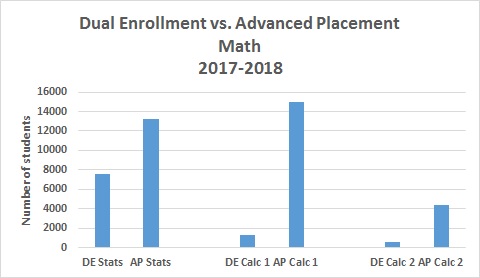
Comparisons between enrollments in: Dual Enrollment STA 2023 Elementary Statistics and AP Statistics; Dual Enrollment MAC X311 Calculus with Analytic Geometry 1 and AP Calculus AB; and Dual Enrollment MAC X312 Calculus 2 and AP Calculus BC.
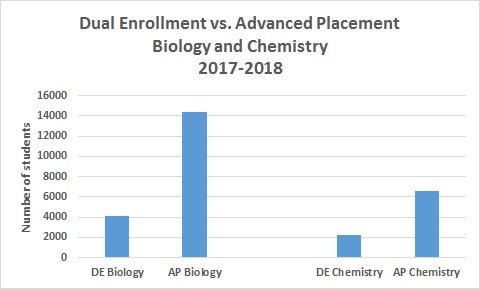
Comparisons between enrollments in: Dual Enrollment BSC X010 General Biology 1 and AP Biology; and CHM X045 General Chemistry 1 and AP Chemistry.

Comparisons between enrollments in: Dual Enrollment PHY 2053 General Physics 1 and AP Physics 1; Dual Enrollment PHY 2054 General Physics 2 and AP Physics 2; Dual Enrollment PHY 2048 General Physics with Calculus 1 and AP Physics C Mechanics; and Dual Enrollment PHY 2049 General Physics with Calculus 2 and AP Physics C Electricity and Magnetism.
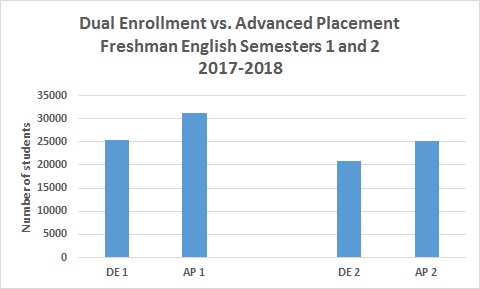
Comparisons between enrollments in: Dual Enrollment ENC 1101 Freshman English 1 and AP English Language and Composition; Dual Enrollment ENC 1102 Freshman English 2 and AP English Literature and Composition.
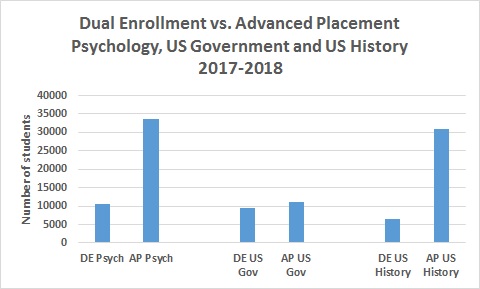
Comparisons between enrollments in: Dual Enrollment PHY X012 Introduction to Psychology and AP Psychology; Dual Enrollment POS 1041 American Government and AP U.S. Government and Politics; and Dual Enrollment AMH 2010 U.S. History 1 and AP U.S. History.
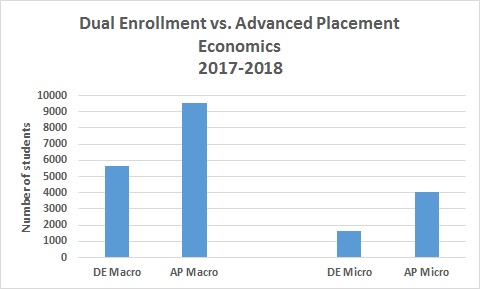
Comparisons between enrollments in: Dual Enrollment ECO 2013 Macroeconomics and AP Macroeconomics; and Dual Enrollment ECO 2023 Microeconomics and AP Microeconomics.

Pingback: Dual enrollment, early college, and the engineering and physics pipelines: A map of the eight years from 9th grade to bachelor’s degree | Bridge to Tomorrow